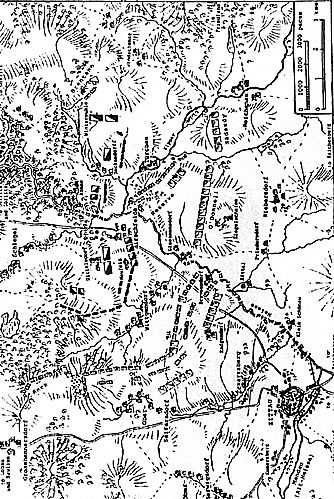At 3 o'clock this morning, Marshal Daun rode out accompanied by torches. Despite the very unpleasant weather, the Princes of Saxony and other volunteers accompanied him. As the first glimmers of dawn started to appear, we found ourselves at the right of the first line in front of Regiment Harrach. It was there that the Marshal made new dispositions to receive the Prussians, whom we never doubted would wish to attack us. The 6 battalions of the Corps of Nádasdy, together with 6 others and 2 regiments of cavalry drawn from the Left Wing, formed a second line behind that which had drawn up yesterday on the height above Wittgendorf. Having arrived at the front, His Royal Highness Prince Charles of Lorraine inspected the line with Marshal Daun.
Several deserters confirmed that the Prussian army had passed the night in bivouac; they believed that the King of Prussia intended to attack.
During the night, there had been skirmishing around Hirschfelde. This made us believe that the Prussians might try to pass the Neisse. Because of this, General Anton Graf Colloredo, who commands the Reserve Corps on the far side of the Neisse, was directed to advance a short distance so that he would be able to dispute the passage. In its new position, the Reserve rests its left at a wood on the banks of the Neisse opposite Hirschfelde; its right is at another wood towards the mountains of Friedland having, in its front, the village of Seckendorff. The cavalry of the Left Wing, under the orders of General O'Donnell, had, until then, remained on the other side of the Neisse to cover the Headquarters. That cavalry now came up as a second line to support the Reserve Corps.
The Prussians made several movements whose purpose could not be distinguished. Finally, towards 9 o'clock in the morning, we heard cannon fire from the left of the Reserve Corps. It appeared that the Prussians had thrown some bridges across below Hirschfelde and that the Reserve was cannonading them as they crossed the river. As a result, we dispatched an order to General Nádasdy immediately to march to the other side of the Neisse and to go and establish himself on the heights of Friedland, so as to cover the right flank of the Reserve.
The Prussians passed a body of 15 to 20,000 men, under the command of General Winterfeldt, across the Neisse. These went to the height of Ronau. They had with them 8 to 10 12-pounder cannon; these outranged the Austrian guns, which were only 6-pounders. The Prussians then continued to file through the village of Seckendorff, marching towards the mountains of Friedland. There, they encountered the Croats of Colonel Brentano, who was on his way back from Gorlitz with 1,000 Warasdiner Croats and 500 horse. Colonel Brentano occupied the woods and house of Wintermuhle and prevented the Prussians from passing. The Prussian corps then encamped between Ronau and Turchau in full view of the Reserve.
The day starting to draw towards its close, His Royal Highness Prince Charles saw that nothing decisive was going to happen today; the weather had rendered the ground extremely slippery and unsuitable for operations. Accordingly, His Royal Highness gave the order to bring forward the tents so that the soldiers might shelter from the rain to which they had been exposed all day. The army did not leave its positions; it encamped where it stood, in battle array. If, despite the excellence of the Austrian position, the King had wished to attack, then we believe that the action would have started on our right - where it connected to the Reserve, with a direct communication by 4 bridges. Had he beaten the Austrian right, the King would then have been able to occupy the heights on which it had stood; without possession of those heights, I cannot see how he could have gained the advantage.

More Journal of Horace St. Paul 1757
-
Part 1: Introduction (June 30-July 14)
Part 2: Introduction (July 15-July 25)
July 26, 1757
July 27, 1757
July 28, 1757
July 29, 1757
July 30, 1757
July 31, 1757
August 1, 1757
August 2, 1757
August 3, 1757
August 4, 1757
August 5, 1757
August 6, 1757
August 7, 1757
August 8, 1757
August 9, 1757
August 10, 1757
August 11, 1757
August 12, 1757
August 13, 1757
August 14, 1757
August 15, 1757
August 16, 1757
August 17, 1757
August 18, 1757
August 19, 1757
Back to Seven Years War Asso. Journal Vol. XI No. 4 Table of Contents
Back to Seven Years War Asso. Journal List of Issues
Back to Master Magazine List
© Copyright 2000 by James J. Mitchell
This article appears in MagWeb (Magazine Web) on the Internet World Wide Web.
Other military history articles and gaming articles are available at http://www.magweb.com